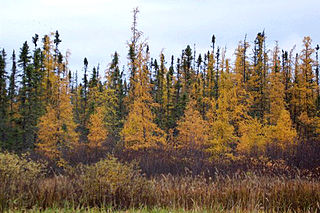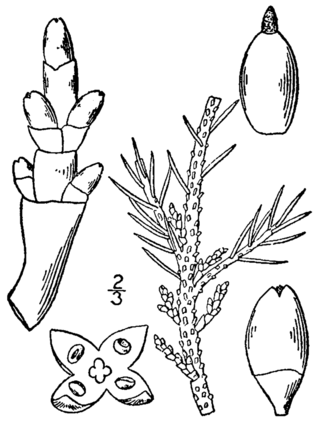Related Research Articles

A spruce is a tree of the genus Picea, a genus of about 40 species of coniferous evergreen trees in the family Pinaceae, found in the northern temperate and boreal (taiga) regions of the Earth. Picea is the sole genus in the subfamily Piceoideae. Spruces are large trees, from about 20 to 60 m tall when mature, and have whorled branches and conical form.

Picea abies, the Norway spruce or European spruce, is a species of spruce native to Northern, Central and Eastern Europe.

Pinus elliottii, commonly known as slash pine, is a conifer tree native to the Southeastern United States. Slash pine is named after the "slashes" – swampy ground overgrown with trees and bushes – that constitute its habitat. Other common names include swamp pine, yellow slash pine, and southern Florida pine. Slash pine has two different varieties: P. e. var. elliottii and P. e. var. densa. Historically, slash pine has been an important economic timber for naval stores, turpentine, and resin. The wood of slash pine is known for its unusually high strength, especially for a pine. It exceeds many hardwoods and is even comparable to very dense woods such as black ironwood.

Larix laricina, commonly known as the tamarack, hackmatack, eastern larch, black larch, red larch, or American larch, is a species of larch native to Canada, from eastern Yukon and Inuvik, Northwest Territories east to Newfoundland, and also south into the upper northeastern United States from Minnesota to Cranesville Swamp, West Virginia; there is also an isolated population in central Alaska.

Diplodia tip blight, also known as Sphaeropsis blight, is a widespread disease affecting conifers caused by an opportunistic fungal pathogen, Diplodia sapinea. It is found in “both hemispheres between the latitudes 30° and 50° north and south". The diseases symptoms include: damping off and collar rot of seedlings, stem canker, root disease, and, most commonly, shoot blight. These symptoms have caused significant economic loss to nurseries and pine plantations. In a nursery in the north-central United States, losses of 35% have been reported. Shoot blight and eventual die back can cause a reduction of marketable volume in timber by 63%. Infection of terminal shoots can result in dead-top which significantly limits the usable length of the tree trunk. The presence of the pathogen in concert with severe weather conditions can lead to extreme loss. Following a severe hailstorm in South Africa, nearly 5,000 acres of pine plantation were infected with Diplodia tip blight. It was necessary to prematurely harvest large swaths of the plantations resulting in a loss of 45%. Areas that were not harvested prematurely still suffered an average timber loss of 11%.

Anisogramma anomala is a plant pathogen that causes a disease known as Eastern filbert blight on Corylus spp. (hazlenut). Also known as EFB.
Eutypella canker is a plant disease caused by the fungal pathogen Eutypella parasitica. This disease is capable of infecting many species of maple trees and produces a large, distinguishable canker on the main trunk of the tree. Infection and spread of the disease is accomplished with the release of ascospores from perithecia. Therefore, the best way to manage the Eutypella canker is to remove trees that have been infected. If infected, it can decrease the quality of wood cut for lumber and can thus have a negative economic impact.

Spruce-pine-fir (SPF) is a classification of lumber that can be traded on commodities exchanges.

Cydia pactolana, the spruce bark tortrix, is a moth of the family Tortricidae. It is found in central, northern and eastern Europe as well as Siberia. In Japan, the subspecies Cydia pactolana yasudai is present.

Fusarium circinatum is a fungal plant pathogen that causes the serious disease pitch canker on pine trees and Douglas firs. The most common hosts of the pathogen include slash pine, loblolly pine, Monterey pine, Mexican weeping pine, and Douglas fir. Like other Fusarium species in the phylum Ascomycota, it is the asexual reproductive state of the fungus and has a teleomorph, Gibberella circinata.

Leucostoma canker is a fungal disease that can kill stone fruit. The disease is caused by the plant pathogens Leucostoma persoonii and Leucostoma cinctum (teleomorph) and Cytospora leucostoma and Cytospora cincta (anamorphs). The disease can have a variety of signs and symptoms depending on the part of the tree infected. One of the most lethal symptoms of the disease are the Leucostoma cankers. The severity of the Leucostoma cankers is dependent on the part of the plant infected. The fungus infects through injured, dying or dead tissues of the trees. Disease management can consist of cultural management practices such as pruning, late season fertilizers or chemical management through measures such as insect control. Leucostoma canker of stone fruit can cause significant economic losses due to reduced fruit production or disease management practices. It is one of the most important diseases of stone fruit tree all over the world.

Hylastes ater is a species of beetle in the family Curculionidae, the true weevils. It is a bark beetle, a member of the subfamily Scolytinae. Its common name is the black pine bark beetle. It is native to Europe and parts of Asia, including China and Korea. It is known as an introduced species in many other regions, including Australia, New Zealand, the Americas, and South Africa. It is a pest of pines and other trees, and it is widespread in areas where pine trees are cultivated. The species "is an important threat to the biosecurity of all forested countries."
The foamy bark canker is a disease affecting oak trees in California caused by the fungus Geosmithia sp. #41 and spread by the Western oak bark beetle. This disease is only seen through the symbiosis of the bark beetles and the fungal pathogen. The bark beetles target oak trees and bore holes through the peridermal tissues, making tunnels within the phloem. The fungal spores are brought into these tunnels by the beetles and begin to colonize the damaged cells inside the tunnels. Symptoms of the developing fungus include wet discoloration seeping from the beetle entry holes as the fungus begins to consume phloem and likely other tissues. If bark is removed, necrosis of the phloem can be observed surrounding the entry hole(s). As the disease progresses, a reddish sap and foamy liquid oozes from entry holes, thus giving the disease the name foamy bark canker. Eventually, after the disease has progressed, the tree dies. This disease is important because of its detrimental effects on oak trees and its ability to spread to several new Californian counties in just a couple of years.

Hypoxylon canker of shade trees is a weak ascomycete fungus that negatively affects growth and can eventually lead to the death of weak or diseased host trees. There are many different species that affect different trees. For example, Hypoxylon atropunctatum, a common species, is found on oak trees, Hypoxylon tinctor affects sycamore trees, and Hypoxylon mammatum infests aspen trees.

Spruce broom rust or yellow witches' broom rust is a fungal plant disease caused by the basidiomycete fungus known as Chrysomyxa arctostaphyli. It occurs exclusively in North America, with the most concentrated outbreaks occurring in northern Arizona and southern Colorado on blue and Engelmann spruce, as well as in Alaska on black and white spruce. This disease alternates its life cycle between two hosts, with the spruce serving as the primary host and bearberry serving as the secondary or alternate host. The name for the disease comes from the distinctive “witches broom”, commonly yellow in color, which forms on the spruce after young needles have been infected. Management must be carried out through physical or mechanical methods, such as the pruning of brooms or the removal of the secondary host from the area, because no chemical control measures have yet been determined to be economically effective. Generally, spruce broom rust is seen as a mostly cosmetic issue, and it is very rarely the direct cause of tree death; however, research has shown a reduction in overall productivity and health of infected trees, making it an important issue for logging and timber companies.

Arceuthobium pusillum is a perennial, obligate parasitic plant in the sandalwood family. Its common names include Dwarf mistletoe or Eastern dwarf mistletoe. It is one of the most widespread dwarf mistletoes within its range which covers the eastern United States and Canada, from Saskatchewan to Nova Scotia and New Jersey. The species name "pusillum" derives from Latin "pusillus", meaning very small.

Cryphalus piceae, the small fir bark beetle, is a tiny bark beetle, about 1.7 mm long that is found in central and southern Europe. It infests mainly fir (Abies) and spruce trees (Picea) and occasionally can cause damage to branches and young trees, including tree death.
References
- 1 2 3 4 5 6 7 Sinclair, W.A., H.H. Lyon, and W.T. Johnson. 1987. Diseases of Trees and Shrubs. Comstock Publishing, Cornell University Press, Ithaca, NY. 168 pp.
- 1 2 3 4 5 6 7 Kamiri, L.K.; Laemmlen, F.F., 1981a. Epidemiology of Cytospora canker caused in Colorado blue spruce by Valsa kunzei. Phytopathology 71: 941-947.
- 1 2 3 4 Kamiri, L.K.; Laemmlen, F.F., 1981b. Effects of drought stress and wounding on Cytosprora canker development on Colorado blue spruce. Journal of Arboriculture 7: 113-116.
- 1 2 3 4 5 6 7 8 9 10 "IPM : Landscape and Turf : Cytospora or Leucostoma Canker of Spruce". Archived from the original on 2010-07-30. Retrieved 2011-05-04.
- 1 2 3 4 5 "Archived copy" (PDF). Archived from the original (PDF) on 2011-09-19. Retrieved 2011-05-04.
{{cite web}}: CS1 maint: archived copy as title (link) - 1 2 Waterman, A.M., 1955. The relation of Valsa kunzei to cankers on conifers. Phytopathology 45: 686-692.
- 1 2 Merrill, W.; Wenner, N. G.; Peplinski, J. D., 1993. New host distribution records from Pennsylvania conifers. Plant Disease 77: 430-443.
- 1 2 3 4 5 6 Lavallee, A, 1964. A larch canker caused by Leucostoma kunzei (Fr.) Munk ex Kern. Canadian Journal of Botany. 42: 1495-1502.
- 1 2 Grove, W.B., 1923. The British Species of Cytospora. Royal Botanic Gardens, Kew. Bulletin of Miscellaneous Information, Vol. No.1 (1923) 15-16 pp.
- 1 2 3 4 5 6 Kavak, H., 2005, Cytospora kunzei on plantation-grown Pinus eldrica in Turkey. Australasian Plant Pathology 34: 151-156.
- 1 2 3 4 5 6 "BP-38". Archived from the original on 2011-07-24. Retrieved 2011-05-04.